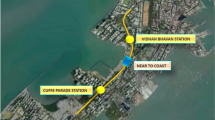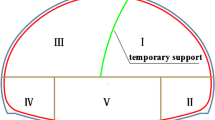Abstract
The negative consequences on TBM performances caused by an insufficiently complete and detailed “geo” characterization of the rock masses that have to be bored are discussed in the paper taking into account the possible ground probing operations in a TBM bored tunnel and the ground treatment techniques to be carried out ahead of the face that can be applied to make the construction of a bored tunnel feasible when limiting or prohibitive conditions for a TBM, must be faced. A description of some relevant and inspiring projects of TBM bored tunnels in rock where ground probing and treatments were used are also presented and discussed.tic approach and concept of physical volume of an inhomogenous medium. The numerical experiments on representative structures of rock masses have shown a good correspondence between the results obtained with the accurate and equivalent models
Similar content being viewed by others
References
S. Pelizza and P. Grasso, “Tunnel collapses: are they unavoidable?” World Tunnelling (1998).
S. Pelizza, “Long TBM drives in rock formation,” Seminar on Design, Construction, Operation and Other Aspects of Tunnels, Malaysia (2000).
D. Peila, “Indagini preliminari nella costruzione di galleries: analisi della letteratura tecnica,” Geoingegneria Ambientale a Mineraria, 127 (2009).
H. H. Einstein, “Risk and risk analysis in rock engineering,” Tunnelling and Underground Space Technology, 11 (1996).
British Tunnelling Society, Tunnel Lining Design Guide, Thomas Telford, London (2004).
ITA/AITES WG on General Approaches to the Design of Tunnels, “Guidelines for the design of tunnels,” Tunnelling and Underground Space Technology, 3 (1988).
ITA/AITES WG 17, Long Tunnel at Great Depth - Final Report, ITA/AITES, Lausanne (2003).
ITA/AITES WG 2, “Guidelines for tunnelling risk management,” Tunnel and Underground Space Technology, 19 (2004).
H. Parker, “Geotechnical Investigations,” Tunnel Engineering Handbook, Kluwer Pub., Boston (1996).
S. Pelizza, “Selection of TBMs,” Workshop on Selection of Tunnelling Methods, World Tunnel Congress 98, Sao Paulo, Brazil (1998).
S. Pelizza and D. Peila, “Soil and rock reinforcements in tunnelling,” Tunnelling and Underground Space Technology, 3 (1993).
ITA/AITES WG 14, Recommendations and Guidelines for Tunnel Boring Machine, Lausanne (2000).
S. Pelizza, “Engineering risk in tunnelling,” Underground Construction in Germany, Ed. STUVA (2000).
S. Pelizza and D. Peila, “Rock TBM tunnelling,” Jubilee Volume in Celebration of 75th Anniversary of K. Terzaghi“s “Erdbaumechanik”, Technische Universitat Wien (2001).
G. Barla and S. Pelizza, “TBM tunnelling in difficult ground conditions,” Geo Eng 2000, Melbourne (2000).
A. Fruguglietti, V. Guglielmetti, P. Grasso, G. Carrieri, and S. Xu, “Selection of the right TBM to excavate weathered rocks and soils,” ITA World Tunnel Congress’ 99 Challenges for the 21st Century, Oslo (1999).
G. S. Kalamaras, “A probabilistic approach to rock engineering design: application to tunnelling,” Milestones in Rock Engineering—The Bieniawski Jubilee Collection, Balkema (1996).
S. Pelizza, “Position Paper No. 3, Ground Treatment.” IV UN-ITA Workshop Gibraltar Strait Crossing, Madrid (2005).
E. Chiriotti, P. Grasso, and S Xu, “Analysis of tunnelling risks: state-of-the-art and examples,” Gallerie e Grandi Opere Sotterranee, 69 (2003).
K. Kovari, “Safety Systems in Urban Tunnelling — The Zimmerberg Tunnel,” Int. Congress on Mechanized Tunnelling Challenging Case Histories, GEAM/SIG, Torino (2004).
C. Oggeri, “Relevant features for tunnelling control by quality procedures,” Gallerie e Grandi Opere Sotterranee, 73 (2004).
USNC/TT, “Geotechnical site investigations for underground projects,” National Research Council, Washington (1984).
N. Barton, TBM Tunnelling in Jointed and Faulted Rock, Balkema, Rotterdam (2000).
J. McFeat-Smith and M. Concilia, “Investigation, prediction and management of TBM performance in adverse geological conditions,” Gallerie e Grandi Opere in Sotterranee, 62 (2000).
R. Grandori, “Avanzamento meccanico in condizioni estreme. Scelta del tipo di TBM e sue caratteristiche,” 3rd Symp. Européen de la Cconstruction des Tunnels, Berna (1996).
R. Grandori, “The universal TBM in the year 2000. Technical aspects and contractor consideration,” Gallerie e Grandi Opere Sotterranee, 50 (1996).
S. Pelizza and D. Peila, “Ground probing and treatments in rock TBM tunnelling: state of the art and innovations,” in: What Future for the Infrastructure? Innovations & Sustainable Development, Bocca Ed., Patron Editore, Bologna (2008).
G. Carrieri, “Report: Guidelines for the selection of TBMs - Recommendation and guidelines for TBMs,” ITA-AITES WG 14, Lausanne (2000).
J. R. Foster. “Gibraltar Strait crossing, characterization of TBM,” UN/ITA Workshop on Characterization for Tunnelling Flysches, Tarifa (1997).
G. Klados and Y. H. Kok, “Selection and performance of TBM in Karstic Limestone—SMART case,” Int. Congress on Mechanized Tunnelling “Challenging Case Histories”, GEAM/SIG, Torino (2004).
J. M. Demorieux, “Reconnaissances a l“advancement a partir du TBM,” UN/ITA Workshop on Gibraltar Strait Fixed Link “Characterisation on TBM for Tunnelling Flysche”, Tarifa (1997).
E. Leca, “Investigation ahead of the face,” EUPALINOS 2000 General Report, AFTES Ed., Paris (2000).
R. Leonardi, Kunming Zhangjiuhe Water Diversion and Water Supply project. The influence of geological adversities on TBM performances,” Int. Congress on Mechanized Tunnelling “Challenging Case Histories”, GEAM/SIG, Torino (2004).
D. Fabbri, “Experiences from the ground probing in the Gotthard-Base tunnel,” ITA Training Course: Tunnel Engineering, Istanbul (2005).
K. Kovari and F. Descoeuders, Tunnelling Switzerland, Swiss Tunnelling Society, Zurich (2001).
J. M. Galera, “Sonic soft ground probe system adapted to TBM,” UN/ITA Workshop on Characterization of TBM for Tunnelling Flysches, Tarifa (1997).
J. M. Galer and S. Pescador, “Métodos geofìsicos no destructivos para predecir el terreno por delante de las tuneladoras,” IV UN-ITA Workshop on Gibraltar Strait Crossing, Madrid (2005).
L. Sambuelli, A. Godio, V. Socco, A. Dall“Ara, G. Vaira, and G. Deidda, “Metodi geofisici per la caratterizzazione degli ammassi rocciosi,” MIR 2004, Torino (2004).
P. P. Marcheselli and M. Ludde, “Esplorazione geologico-tecnica in tempo reale davanti alla testa fresante di TBM,” Convegno su: Le indagini geologiche e geotecniche propedeutiche alla costruzione delle opera sotterranee sia civile che minerarie, GEAM Ed., Modena (2002).
S. Mitani, T. Iwai, and H. Isahai, “Relations between conditions of rock mass and TBM“s feasibility,” Proc. 6th ISRM Congress, 1, Montreal (1987).
S. Mitani, “State of the art of TBM excavation and probing ahead technique,” Proc. 8th IAEG Congress, Vancouver (1989).
T. Morimoto and M. Hori, “Performance characteristics of tunnel boring machine from the geomechanical viewpoint,” Int. J. Rock Mech. Min. Sci., 23 (1986).
K. Nishioka and K. Aoki, “Hard rock tunnel boring prediction and field performance,” Proc. RETEC, Boston (1998).
I. Vielmo, “Grouting ad drainage treatment with relevant boring layouts,” IV UN-ITA Workshop on Gibraltar Strait Crossing, Madrid (2005).
D. Peila and S. Pelizza, “Ground reinforcing and steel pipe umbrella system in tunnelling,” Advances in Geotechnical Engineering and Tunnelling - Rational Tunnelling, Logos Verlag, Berlin (2003).
AFTES, “Recommendation on grouting for underground works, ” Tunnelling and Undeground Space Technology, 6 (1991).
ISRM, Final Report, Commission on Rock Grouting (1995).
G. Lombardi and D. Deere, “Grouting design and control using the GIN principle,” Water Power & Dam Construction (1993).
Y. Y. Tseng, S. L. Wong, B. Chu, and C. H. Wong, “The Pinglin mechanized tunnelling in difficult ground,” 8th Congress IAEG, Vancouver (1998).
Wen-Lon Cheng, “Hsuean Tunnel and TBM,” Int. Congress on Mechanized Tunnelling “Challenging Case Histories”, GEAM/SIG, Turin (2004).
R. Grandori and P. Romualdi, “The Abdalajis tunnel (Malaga-Spain). The new Double Shield Universal TBM challenge,” Int. Congress on Mechanized Tunnelling: Challenging Case Histories, GEAM/SIG, Turin (2004).
Garnier, Pierron, Botte, Lebert, Giafferi and Vaskou, “Javanon Tunnel. Buetch development. Exceptional geological difficulties encountered when boring with a tunnel boring machine and adopted provisions,” Proc. Congr. on Soil and Rock Improvement in Underground Works, 2, Milan (1991).
E. Bethaz, S. Fuoco, S. Mariani, P. Porcari, and E. Rosazza Bondibene, “Riser tunnel excavation with TBM: the experience of the Maen tunnel,” Gallerie e Grandi Opere Sotterranee, 61 (2000).
A. Bellini, R. De Domenico, and G. Da Forno, “Gli infilaggi metallici a contatto per il superamento con fresa scudata a piena sezione di una frana al fronte in graniti completamente degradati, con forti venute d“acqua,” Proc. Congr. on Soil and Rock Improvement in Underground Works, SIG, 1, Milan (1991).
F. Zerilli and S. Campostrini, “Scavo di una galleria in sabbie fluenti. Interventi speciali di consolidamento e drenaggio,” Proc. Congr. on Soil and Rock Improvement in Underground Works, SIG, 2, Milan (1991).
G. Lombardi, Die Piora-Mulde. Gotthard Basistunnel Sud, Delegation der Tessiner Parlamentarier, Lo, Minusio (CH) (1997).
E. Grov, “Introduction to water control in Norwegian tunnelling,” Water Control in Norwegian Tunnelling, Norwegian Tunnelling Society (2002).
O. T. Blindheim and E. Ovstedal, “Design principles and construction methods for water control in subsea road tunnels in rock,” Water Control in Norwegian Tunnelling, Norwegian Tunnelling Society (2002).
M. Brantberger, H. Stille, and M. Eriksson, “Controlling grout spreading in tunnel grouting - analyses and developments of the GIN-method,” Tunnelling and Underground Space Technology, 15 (2000).
K. Miyaguchi, “Maintenance of the Kanmon Railway Tunnels,” Tunnelling and Underground Space Technology, 1 (1986).
S. Matsuo, “An overview of the Seikan Tunnel project,” Tunnelling and Underground Space Technology, 1 (1986).
Y. Maru and T. Maeda, “Construction of the Seikan Undersea Tunnel - I. General scheme of execution,” Tunnelling and Underground Space Technology, 1 (1986).
Y. Mochida, “Rock mechanics in the Seikan Tunnel,” Rock Mechanics in Japan, Japanese Committee for ISRM, Tokio (1991).
K. Hashimoto and Y. Tanabe, “Construction of the Seikan Undersea Tunnel - II. Execution of the most difficult sections,” Tunnelling and Underground Space Technology, 1 (1986).
B. Nilsen and A. Palmstrøm, “Stability and water leakage of hard rock subsea tunnels,” Int. Cong. Modern Tunnelling Science and Technology, Kyoto, Japan (2001).
N. Barton, B. Buen, and S. Roald, “Strengthening the case of grouting. Part 1,” Tunnels & Tunnelling, December (2001).
N. Barton, B. Buen, and S. Roald, “Strengthening the case of grouting. Part 2,” Tunnels & Tunnelling, January (2002).
U. Fredriksen and E. Broch, “Grouting of Sewer Tunnels in Oslo,” Advances in Tunnelling Technology and Subsurface Use, 4 (1984).
H. Bejui and T. Avril, “French experience in the field of submarine tunnelling,” Tunnelling and Underground Space Technology, 1 (1986).
A. Balossi Restelli, “Chemical grouting treatment to allow the excavation of tunnels in rocks affected by infiltrations of toxic gas under pressure,” International Tunnel Symposium’ 78: Tunnelling Under Difficult Conditions, J.T.A., Tokio (1978).
Author information
Authors and Affiliations
Corresponding author
Additional information
Translated from Fiziko-Tekhnicheskie Problemy Razrabotki Poleznykh Iskopaemykh, No. 6, pp. 100-116, November-December, 2009.
Original article submitted August 5,2009.
Rights and permissions
About this article
Cite this article
Peila, D., Pelizza, S. Ground probing and treatments in rock TBM tunnel to overcome limiting conditions. J Min Sci 45, 602–619 (2009). https://doi.org/10.1007/s10913-009-0075-9
Published:
Issue Date:
DOI: https://doi.org/10.1007/s10913-009-0075-9




